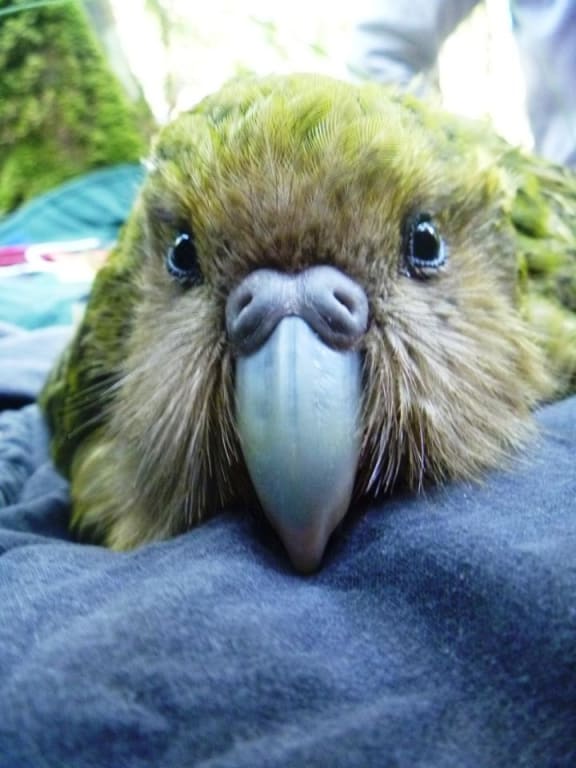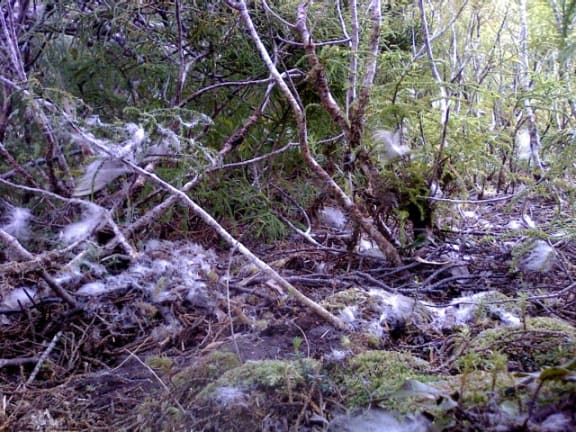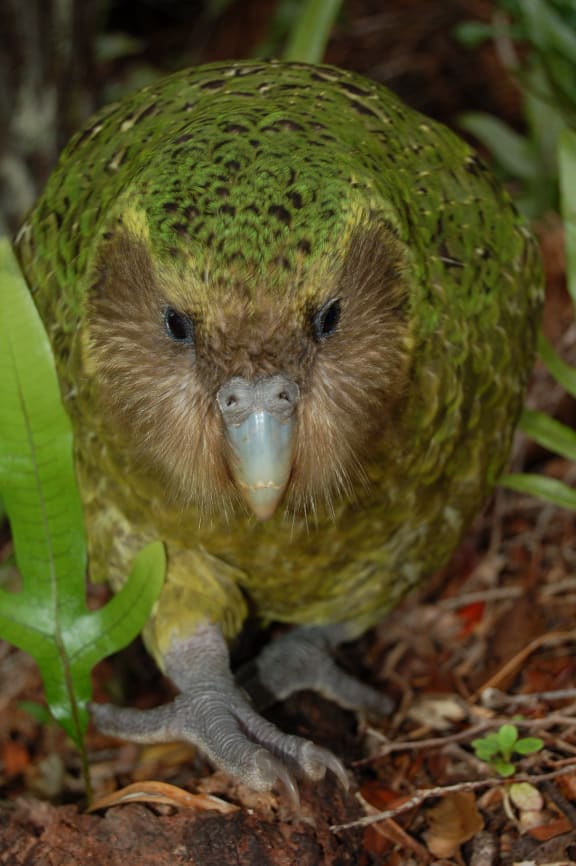Hi-tech electronic surveillance has revealed that kakapo breeding this season has got off to a racing start.

A female kakapo named Kuia has mated for the first time, with two young males called Blake and Kumi. It is exciting news as she is one of just three kakapo with precious Fiordland genes. The mating took place on Anchor Island in Fiordland. Photo: DOC
Seven female kakapo have mated in the last 10 days, since January 9th, including Kuia, a 17-year old bird that carries precious Fiordland kakapo genes and has never bred before.
Department of Conservation kakapo ranger Daryl Eason says that cool spring temperatures meant the department was predicting a late breeding season to occur around mid-February, but eager kakapo have begun breeding more than a month earlier.
And hi-tech electronic surveillance is ensuring that the Kakapo Recovery team is totally up-to-date with the news.
Ten days ago the team was sent an exciting email: the first mating of this year’s breeding season had taken place on remote Anchor Island, in Fiordland.
Since then four more female kakapo on Anchor Island and two on Whenua Hou/Codfish Island, near Stewart Island, also started breeding.
This season looks set to be the first time that kakapo have successfully bred on Anchor Island.
Eason says he predicted there might be 15 kakapo nests this season, which could result in 30-40 chicks.
One of the problems facing the threatened kakapo is that most of the 125 birds are closely related and there is little genetic diversity.
But Kuia and her two brothers, Sinbad and Gulliver, are descended from a kakapo named Richard Henry, who was the last remaining Fiordland kakapo.
Their genes are quite different from the rest of the kakapo population which hails from Stewart Island stock.

Anchor Island, at the entrance to Dusky Sound in Fiordland, is one of three islands where kakapo are managed. This is the first breeding season in which there has been lots of kakapo breeding activity here. Photo: DOC

This kakapo mating sign was left by the young female Hine Taumai and young male Takatimu. They were among the first kakapo to breed this season. Photo: DOC
Population growing but infertility a problem
Although kakapo remain one of New Zealand’s most threatened birds, their outlook has improved dramatically over the last two decades.
In the early 1990s there were just 51 kakapo, most of them aging males, but since 1997 intense management has seen their numbers climb to 125.
The population is now made up of many younger birds and an equal ratio of males and females.
However, high levels of infertility are an ongoing problem dogging conservation efforts. “On average only 60 percent of eggs that are laid are fertile, and in the last breeding season, in 2014, only 40 percent of eggs were fertile, which was very disappointing,” Eason says.
While the lack of genetic diversity is related to the problem of infertility, the number of times a female mates has also been shown to be of critical importance, Eason says.
“A female who mates twice with the same male has an improved chance of laying fertile eggs, but if she mates with two different males there is a 90 percent chance that her eggs will be fertile.”
Kuia, the young Fiordland female, has already mated with two other first-time breeders, Blake and Kumi, which bodes well for the chances of her laying fertile eggs.

There are just 125 kakapo alive at the moment. This is Sirocco, a hand-reared kakapo that is habituated to people. Infertility is a big problem for kakapo conservation, and like a number of male kakapo Sirocco is infertile. Because of this Sirocco is used as a conservation advocate and is not part of the kakapo breeding programme. Photo: DOC
Daryl Eason says he is particularly excited to see a number of young birds that have never bred before finally breeding.
“The males that have bred so far on Anchor Island are all young birds, and we don’t know how that might affect their fertility. It’s exciting as we’ve never had so many young males in the breeding population before, but we don’t know what their performance might be.”
Trees determine the timing
The nocturnal kakapo only breed every 2-4 years, and their breeding is triggered by the mass seeding of podocarp trees, especially rimu. However Eason says that a mass flowering of Nothofagus beech trees on Anchor Island also seems to be playing a role there. “We don’t really know how kakapo react to beech seeding, but we do know that kakapo used to be widespread in Fiordland and they probably relied on beech seed to raise their chicks.”
Kakapo are currently managed on three islands. As well as Anchor and Whenua Hou/Codfish islands, male kakapo on Hauturu/Little Barrier Island, in the Hauraki Gulf, are also carrying out the booming display that marks their readiness to breed, and there is a possibility of breeding on that island as well.
Check Mate, Errols and the Train Station
Electronic surveillance and hi-tech monitoring devices that have been specially developed for the kakapo conservation programme are making a significant difference in kakapo management this year.
All male kakapo carry a small device on their back called a Check Mate. The Check Mate transmitter contains an activity sensor that records how active the bird is, for example whether it’s running towards a feeding station or energetically shaking during a mating.
The Check Mate also contains a proximity sensor to detect the transmitter of any nearby females, and it logs how long she stays around the male. The date and time of the interaction is recorded, and the ‘quality’ of the interaction is also calculated.
The Check Mate transmitter relays all this information via a complex series of beeps, that can either be ‘read’ in the field by a ranger using a radio telemetry set or relayed remotely.
Every morning, between 5am and 7am, the Check Mate transmitters ‘‘talk’’ to a system of electronic receivers called Errols. The Errols are located on strategic highpoints on the kakapo islands. Once they have recorded all the data they transmit it via satellite or a cellphone network to a laptop computer, nick-named the Train Station.
“The rangers on the island can wake up to an email each morning telling them what has happened overnight,” Eason says.
Each female kakapo carries a different kind of transmitter known as an Egg-Timer transmitter. These were developed for use with kiwi and have been refined for kakapo. Egg-Timer transmitters log the daily activity of a female kakapo. Usually she is active for about 9 hours a night, especially if she is travelling long distances to find a mate. But when she starts incubating eggs this will plummet to about 2 hours a night, alerting the rangers to the fact that she has begun nesting. Once again this data can be detected by a ranger in the field or sent via an Errol. “It saves us a lot of time walking around islands trying to locate every female kakapo,” Eason says.
Hands-on management
In the last decade the Kakapo Recovery Team has successfully pioneered the use of artificial insemination in an effort to improve the genetics of the population and improve the fertility rate of eggs. The artificial insemination programme is set to continue on Whenua Hou/Codfish Island this year.
“I’m really looking forward to the day when we can increase the number of chicks being produced just by having more fertile eggs,” Eason says. “It’s always so sad to see infertile eggs.”
The team has also been developing supplementary food to boost breeding and chick survival. A new pumpkin-based food pellet is being trialled this year.
Daryl Eason says they plan to artificially incubate as many kakapo eggs as possible. “We have shown that we are better at safely incubating kakapo eggs than some of the kakapo mums, and we want to reduce the risk as much as possible.”
Wherever possible chicks will be reared by their own mother or by a foster mother, although chicks can be hand-reared if necessary.

